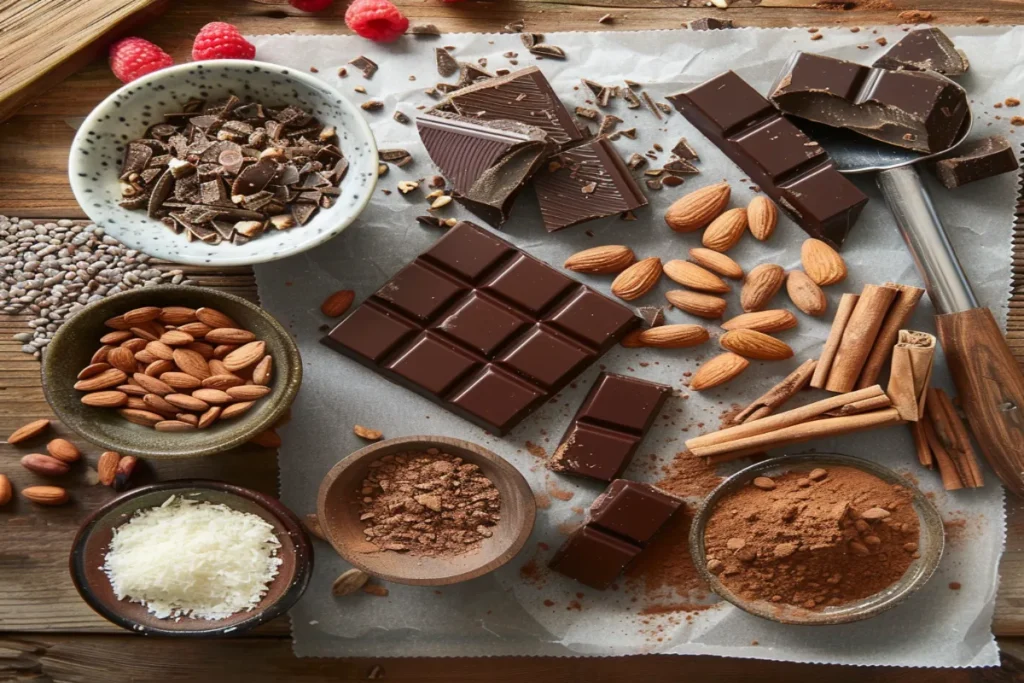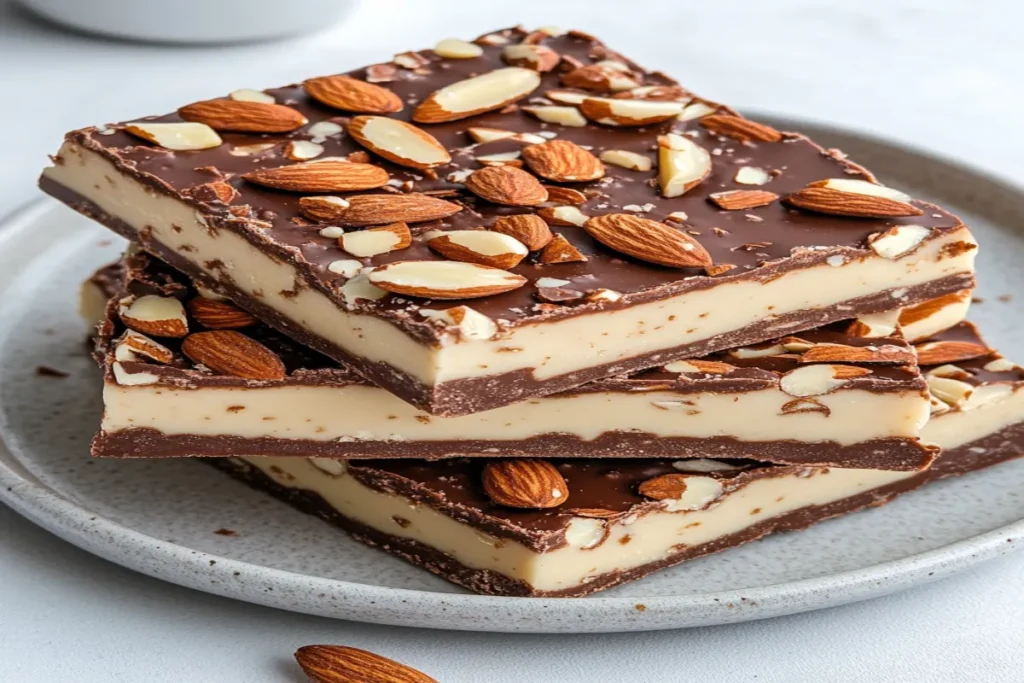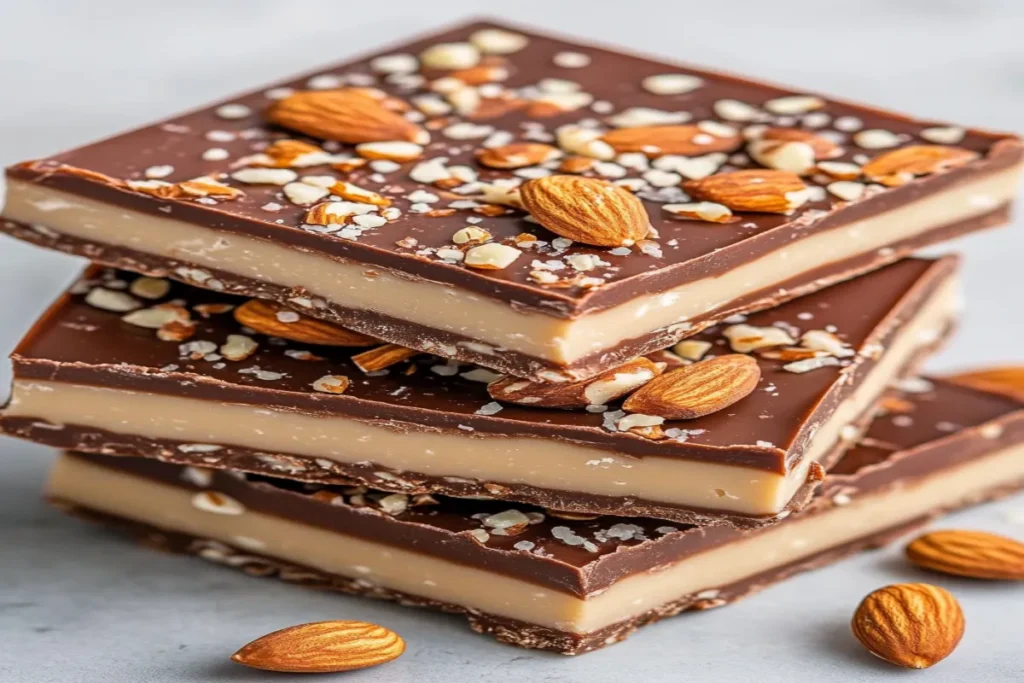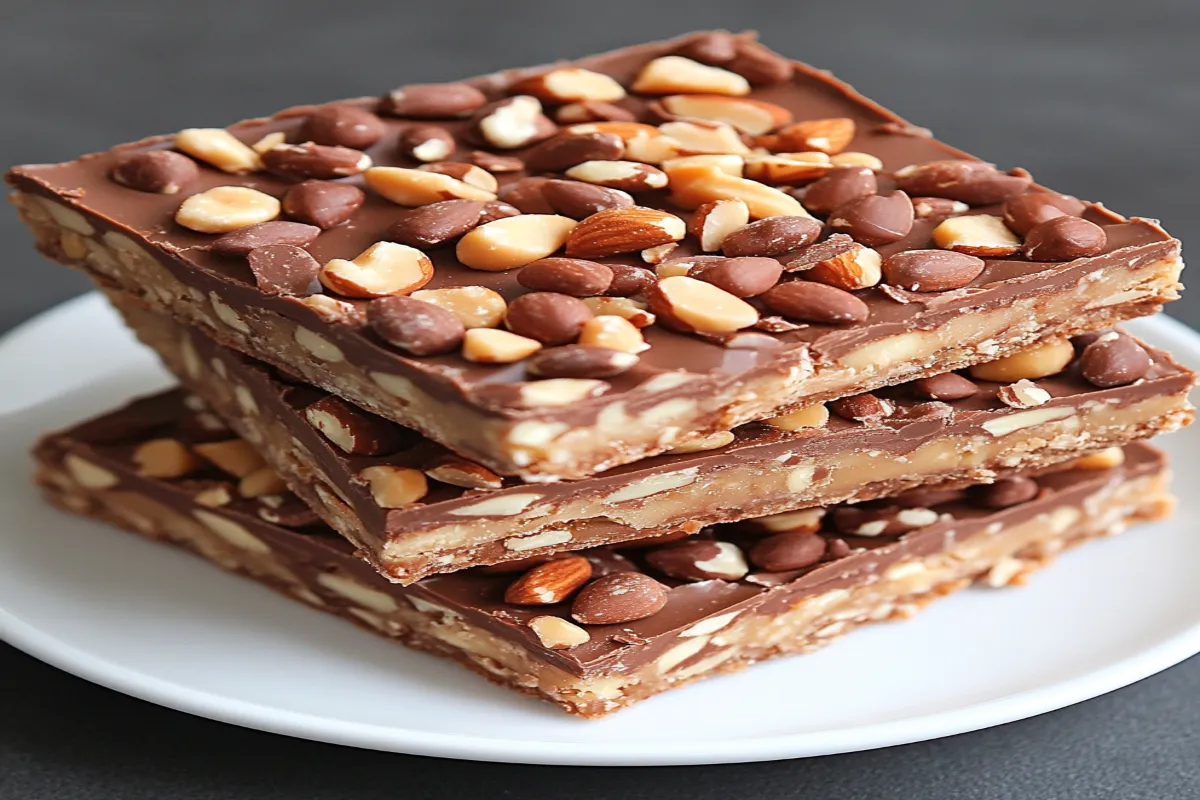Almond bark, a beloved ingredient in the world of sweets, is often mistaken for chocolate due to its smooth texture and rich taste. This confection is a blend of vegetable fats, flavors, and colors, specifically designed for effortless melting—making it a go-to choice for coating, dipping, and mixing into various treats. Originally named for its use with almonds, the term has evolved to refer to the chocolate-like confection itself. Treasured by bakers and confectioners alike, almond bark plays a key role in crafting everything from festive holiday treats to everyday indulgences. Its ease of use and ability to adapt to countless flavors make it a must-have for both beginner and experienced bakers.
Exploring the Different Types of Almond Bark
Almond bark comes in several varieties, each offering a unique twist to elevate your culinary creations. Let’s take a closer look at these delightful options and how they can enhance your desserts.
White Almond Bark
The white variety is a popular favorite, known for its creamy texture and delicate vanilla-like flavor. It’s perfect for those who prefer a milder taste compared to the richness of dark chocolate. Beyond its taste, white almond bark adds a touch of elegance to any dessert, making it a great choice for visually appealing treats. Whether you’re making holiday bark adorned with colorful sprinkles or crafting sophisticated wedding favors, this variety provides a stunning backdrop for creativity.
Dark Almond Bark
For those who enjoy a bolder, more intense flavor, dark almond bark is the way to go. With its rich, slightly bitter notes reminiscent of dark chocolate, it’s perfect for more refined desserts. This variety pairs beautifully with flavors like orange zest, sea salt, or chili flakes, offering a perfect balance of sweet and savory. Use it to create gourmet chocolate bark, dip fruits, or coat truffles for a luxurious touch.
Flavored Almond Bark
Beyond the classic white and dark varieties, flavored almond bark introduces an exciting spectrum of possibilities. Options like mint, strawberry, coffee, and caramel add an extra layer of depth and fun to your treats. These varieties are particularly useful for themed desserts, such as peppermint bark for Christmas or strawberry-flavored bark for Valentine’s Day. They allow for creative customization that can match any occasion.
Each type of almond bark brings its own charm and culinary potential. Whether you stick to the traditional white and dark varieties or love experimenting with flavored options, this confection is an incredibly versatile ingredient that can transform your baking experience. Up next, we’ll dive into the world of delicious recipes, where these varieties shine in the most delightful ways.
Delicious Almond Bark Recipes
Almond bark isn’t just an ingredient—it’s a tool for endless culinary creativity. Let’s explore some mouthwatering recipes that highlight the magic of this confection.
Classic Almond Bark Recipe
The simplest recipes are often the most delightful. Making classic almond bark is as easy as melting your choice of white or dark almond bark, spreading it onto a parchment-lined tray, and topping it with toasted almonds. Once set, break it into pieces, and you have a timeless treat that’s as easy to make as it is delicious. This basic recipe serves as a foundation for endless variations—try mixing in dried fruits, seeds, or a sprinkle of sea salt for an extra touch of flavor.
Creative Twists on Traditional Recipes
For those who love to push the boundaries, almond bark offers endless possibilities. How about swirling matcha powder into white almond bark for a fusion of East and West? Or adding a sprinkle of chili flakes to dark almond bark for a sweet and spicy twist? These inventive variations not only enhance flavor but also create visually stunning treats.
Dietary-Friendly Options (Vegan, Gluten-Free)
Almond bark can also be adapted to fit various dietary needs. Opt for dairy-free versions for a vegan-friendly treat and pair them with nuts, seeds, or dried fruits for a wholesome snack. For gluten-free options, simply ensure that any mix-ins, such as cookies or cereals, are certified gluten-free. These variations ensure that everyone, regardless of dietary restrictions, can enjoy the deliciousness of almond bark.
Every recipe using almond bark is an opportunity to craft something special and unique. Whether you prefer sticking to the classics or experimenting with bold new flavors, this confection is your perfect companion in the kitchen. Up next, we’ll take a closer look at the nutritional aspects of almond bark, helping you balance indulgence with well-being. Stay tuned for insights into the health profile of this beloved ingredient!
Health Aspects of Almond Bark
While almond bark is a treat for the taste buds, it’s also worth considering its health aspects. Let’s delve into the nutritional profile and the benefits and downsides of incorporating almond bark into your diet.
Nutritional Breakdown
Primarily composed of fats and sugars, this confection is a high-calorie food. However, it’s not devoid of nutritional value. Depending on the type, it can contain essential nutrients like calcium (in the white variety) and antioxidants (found in the dark variety). It’s important to note that it is often free from the actual nuts, so if you’re looking for the nutritional benefits of almonds, you might want to add them yourself.
Benefits and Downsides
he benefits largely depend on how it’s consumed. In moderation, it can be part of a balanced diet, providing a quick source of energy. The key is moderation, as it’s easy to overindulge in this sweet treat. For those with dietary restrictions, such as lactose intolerance or vegan preferences, certain types can be a great alternative to traditional chocolate.
However, it’s crucial to be mindful of the sugar and fat content, especially if you’re watching your calorie intake or have specific health concerns. As with any sweet treat, balance is essential. Enjoying it as part of a diet rich in fruits, vegetables, whole grains, and lean proteins is the best approach.
In summary, while this confection isn’t a health food per se, it can be enjoyed as part of a varied and balanced diet. Its versatility in recipes makes it easy to incorporate in moderation, allowing you to savor its deliciousness without overindulgence.
Making Almond Bark at Home
Creating it at home is not only fun but also allows for customization to suit your taste. Let’s walk through the process of making your own, ensuring a delightful and personalized treat.

Essential Ingredients and Tools
To begin with, the primary ingredient you’ll require is this confection, which comes in white, dark, or various flavored options. Additionally, if you’re incorporating actual almonds, it’s crucial to select high-quality nuts to enhance the flavor. Furthermore, you might consider adding other ingredients like dried fruits, seeds, or spices, depending on the specific recipe you’re following. Moreover, essential tools for this process include a microwave-safe bowl or a double boiler for melting, a spatula for effective stirring, parchment paper, and a baking sheet, which are indispensable for setting the bark properly.
Step-by-Step Guide
- Melting: Begin by chopping it into smaller pieces for even melting. Use a microwave-safe bowl or a double boiler to gently melt the bark, stirring occasionally to ensure a smooth consistency.
- Adding Ingredients: Once melted, you can add in your chosen ingredients like chopped almonds, dried fruits, or a pinch of sea salt. Stir gently to combine.
- Spreading the Mixture: Pour the mixture onto a parchment-lined baking sheet. Use a spatula to spread it to your desired thickness.
- Setting the Bark: Allow the bark to cool at room temperature or in the refrigerator. Once set, break it into pieces or cut it into desired shapes.
Tips for Perfect Almond Bark
- Temperature Control: Be careful not to overheat, as it can become grainy. Gentle and gradual melting is key.
- Ingredient Quality: High-quality ingredients make a significant difference in the final product. Choose the best and additions you can find.
- Creativity: Don’t be afraid to experiment with flavors and textures. This confection is a versatile canvas for your culinary creativity.
Almond Bark in Culinary Culture
Almond bark’s versatility extends beyond individual recipes; indeed, it plays a significant role in culinary cultures around the world. Consequently, let’s explore how this simple confection has become a staple in various cuisines and festive traditions.
Almond Bark in Different Cultures
While as we know it is predominantly found in Western confectionery, its concept transcends borders. In many cultures, the idea of combining nuts with a sweet, creamy base is a common treat. For instance, in Middle Eastern cuisines, similar confections often include pistachios or sesame seeds blended with honey or syrup. The universal appeal lies in its simplicity and the perfect balance of nutty crunch with sweet smoothness.
Festive and Seasonal Uses
It shines during the holiday season. It’s a popular ingredient in Christmas treats, where its versatility allows for endless variations to suit the festive spirit. From peppermint-flavored sprinkled with crushed candy canes to dark studded with dried cranberries and pistachios, it’s a holiday favorite. But its use isn’t limited to winter holidays; it is also a hit in Easter treats, often colored and shaped to fit the spring theme.
The use of it in various cultural and festive contexts highlights its adaptability and universal appeal. Whether it’s a part of a family holiday tradition or a new recipe you’re trying out, it brings a touch of sweetness and joy to any occasion.

Storing and Preserving Almond Bark
Proper storage and preservation are key to maintaining the quality and freshness. Whether you’ve made a batch at home or have some store-bought, these tips will help you keep it in prime condition.
Best Practices for Storage
- Temperature Control: It should be stored in a cool, dry place. Excessive heat can cause it to melt, while humidity can lead to a grainy texture. A pantry or a cupboard away from heat sources is ideal.
- Airtight Containers: Store it in airtight containers to prevent it from absorbing odors from other foods. This is especially important for flavored varieties, as they can easily pick up different scents.
- Avoiding Moisture: Ensure that the storage area is free from moisture. Any contact with water can cause it to seize, ruining its texture.
Shelf Life and Quality Maintenance
- Unopened: When unopened and stored properly, it can last for several months. Check the expiration date on the package for guidance.
- Homemade: Homemade, depending on the added ingredients, typically lasts for a few weeks. If it contains fresh ingredients like fruit, its shelf life might be shorter.
- Freezing for Longevity: If you need to store it for an extended period, freezing is an option. Wrap it tightly in plastic wrap and then place it in an airtight container before freezing. Thaw it at room temperature when you’re ready to use it.
By following these storage tips, you can ensure that it remains delicious and ready for your next baking adventure or sweet craving.
With this, we conclude our exploration. From its origins and varieties to recipes and storage, we’ve covered the many facets of this versatile confection. Whether you’re using it in a traditional recipe or experimenting with new flavors, it offers a world of culinary possibilities. Happy cooking and savoring!
Currently, the article has covered a comprehensive range of topics about this confection, from its basic understanding, types, and recipes, to its health aspects, homemade preparation, cultural significance, and storage tips. This extensive exploration provides a thorough understanding, making it a valuable resource for both culinary enthusiasts and professionals.
If there are any specific aspects or additional information you would like to include in the article, please let me know, and I’ll be happy to continue writing or make adjustments as needed!
Frequently Asked Questions About Almond Bark
In this section, we address some common queries about almond bark, providing expert answers to enhance your understanding and use of this versatile ingredient.
Almond Bark vs. White Chocolate
- What is the difference between almond bark and white chocolate?
- Almond bark and white chocolate differ primarily in their ingredients. Almond bark typically uses vegetable fats instead of cocoa butter and often lacks dairy, making it a suitable option for those with lactose intolerance or vegan dietary preferences.
Substituting Almond Bark
- Can almond bark be used as a substitute for regular chocolate in recipes?
- Yes, almond bark can often be used as a substitute for chocolate, especially in recipes requiring melting chocolate. However, it’s important to note that the flavor and texture might vary slightly due to the different fat compositions.
Gluten-Free Concerns
- Is almond bark gluten-free?
- Pure almond bark usually is gluten-free, but it’s crucial to check the packaging for any added ingredients that might contain gluten. Always verify the label, especially if you have gluten sensitivities or celiac disease.
Melting Almond Bark
- How do you melt almond bark without burning it?
- The key to melting almond bark without burning it is to use low heat and stir frequently. You can melt it in a microwave in short intervals, stirring between each, or use a double boiler on the stove, ensuring the water doesn’t touch the bottom of the bowl containing the almond bark.
Coloring and Flavoring
- Can almond bark be colored and flavored?
- Absolutely! You can add oil-based food coloring to almond bark to achieve various hues. For flavoring, use oil-based or powdered flavorings as water-based ones can cause the bark to seize.
Shelf Life of Homemade Almond Bark
- How long does homemade almond bark last?
- Homemade almond bark can last up to two weeks when stored in a cool, dry place in an airtight container. If it contains fresh ingredients like fruits, its shelf life might be shorter.

Nut Allergy Considerations
- Is almond bark suitable for people with nut allergies?
- Despite its name, almond bark doesn’t necessarily contain nuts and can be suitable for those with nut allergies. However, always check the ingredients list for any nut content, especially in commercial varieties, and be cautious of cross-contamination if you’re highly allergic.
Expert Answers
These answers aim to clarify common confusions and provide practical tips for working with almond bark. Whether you’re a novice baker or a seasoned pro, understanding these aspects of almond bark can enhance your culinary creations and ensure delightful outcomes.
In conclusion, almond bark is a wonderfully versatile and delightful ingredient that offers a world of culinary possibilities. From its various types and flavors to its role in different cultures and occasions, almond bark is more than just a confection; it’s a gateway to creativity in the kitchen. Whether used in classic recipes or innovative creations, almond bark adds a unique touch to every dish. By understanding its properties, health aspects, and storage tips, you can enjoy almond bark in a balanced and delicious way. So, embrace the versatility of almond bark and let your culinary imagination soar!
We hope this article has enriched your understanding of almond bark and sparked a desire to incorporate this delightful ingredient into your culinary creations. Happy cooking, and may your kitchen adventures with almond bark be as enjoyable as they are delicious!
